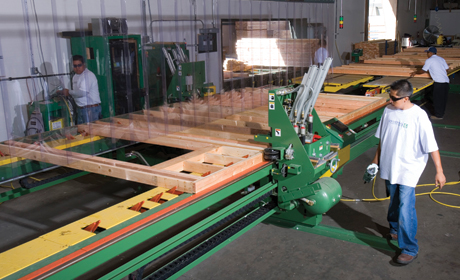For years the word “prefab” received a bum rap in the construction industry. There existed a prevalent viewpoint that unless a home was stick-built by skilled carpenters, it didn’t actually qualify as genuine construction. Over time, the benefits of panelized framing have come to outweigh this misconception and today the use of manufactured house components remains a growing trend nationwide.
The dominant reason is efficiency. There are several reasons home deliveries can fall behind schedule. The most obvious is weather, a factor faced by every Outer Banks builder, but that’s not the only reason for delays. Building on a barrier island has unique challenges and one is the limited number of quality tradesmen available in each field, and these professionals are in high demand while balancing the work load for more than one contractor. Another notable element is delays in building materials deliveries that can occur in our remote location.
In all business it’s true that time is money and construction is no exception. The use of prefabricated wall panels and truss systems eliminates construction delays related to material deliveries. Secondly, when components arrive onsite they are ready for immediate assembly which increases the level of productivity for framing crews allowing them to move efficiently from one jobsite to another.
Exterior wall panels are manufactured from traditional framing timber in a controlled environment. Whereas, stick-built walls are built onsite in unpredictable weather conditions which may impact the quality of materials. The contractor provides shop plans and layout details to the panel manufacturer who feeds this information into a computer program that designs the unique panels required for your home. This includes the precise placement of exterior windows and doors, interior doors and their corresponding headers.
This construction method results in a high quality product with precision cuts that are nailed and screwed together at the factory resulting in a better fit for increased durability. The wall units are then labelled for easy onsite assembly and shipped to construction jobsites where an experienced framing crew can assemble the panels.
When compared to stick-built, wall panels can be installed in a more efficient manner that uses less manpower and poses fewer safety risks to the framing crew. Also, due to the size of these panels substantially less theft occurs then when bundles of raw lumber are delivered to job sites.
The biggest advantage is that panelized components can assembled in fewer days resulting in a lower cost to the contractor, a savings that can then be passed to the homeowner. And, once the home is “dried in,” the contractor can quickly proceed with scheduling interior finishes which results in a more efficient home delivery timeline.

